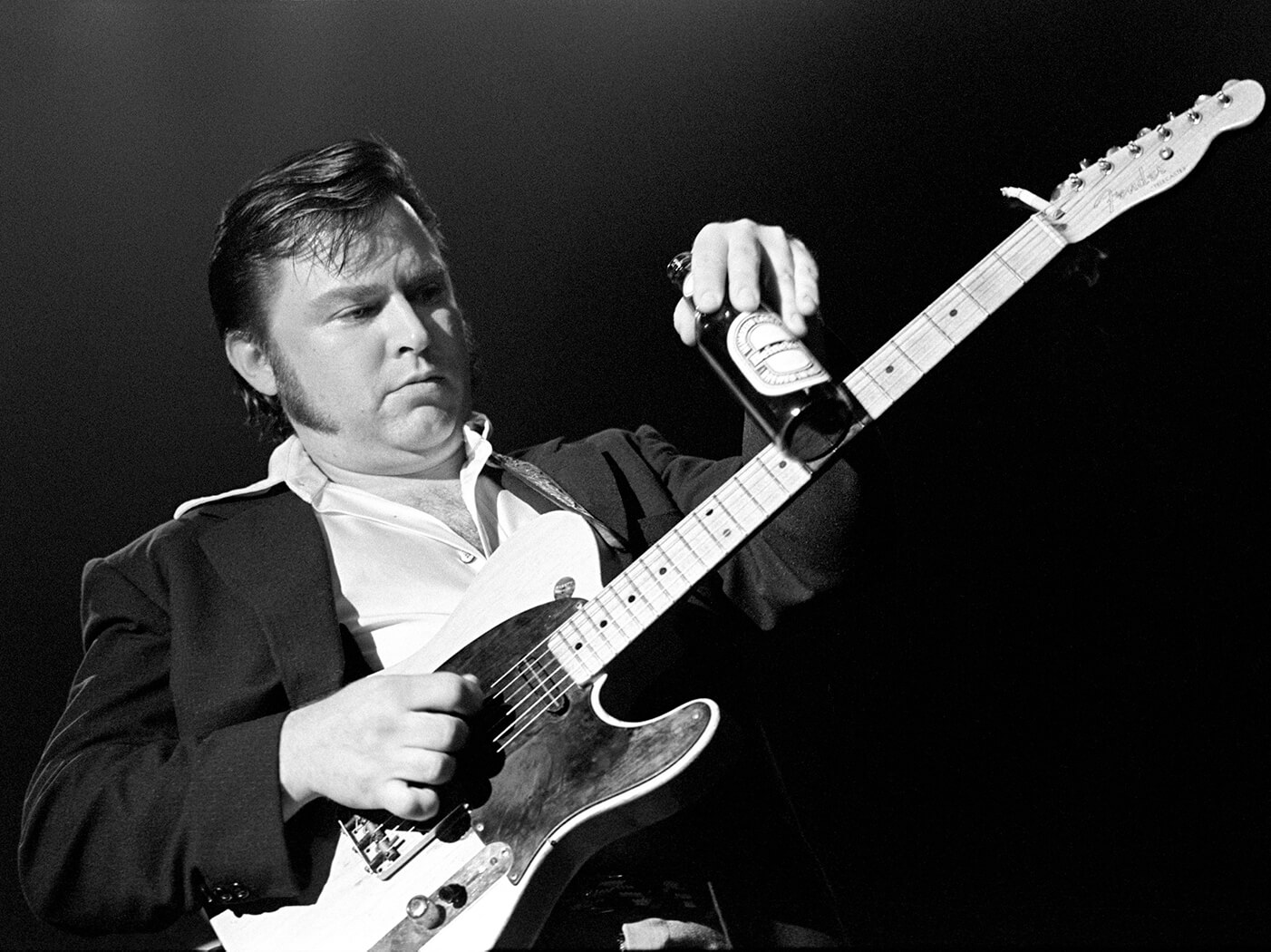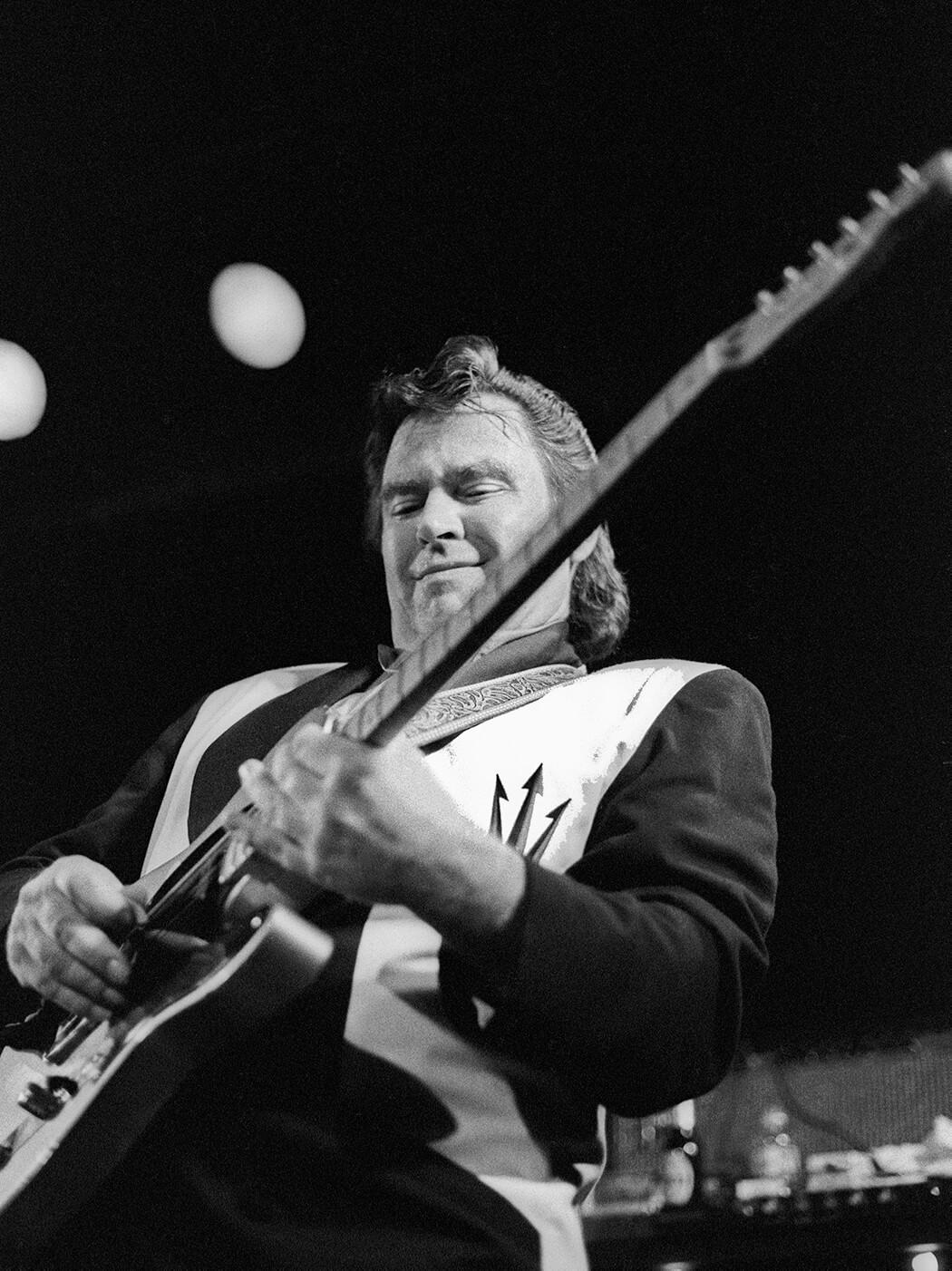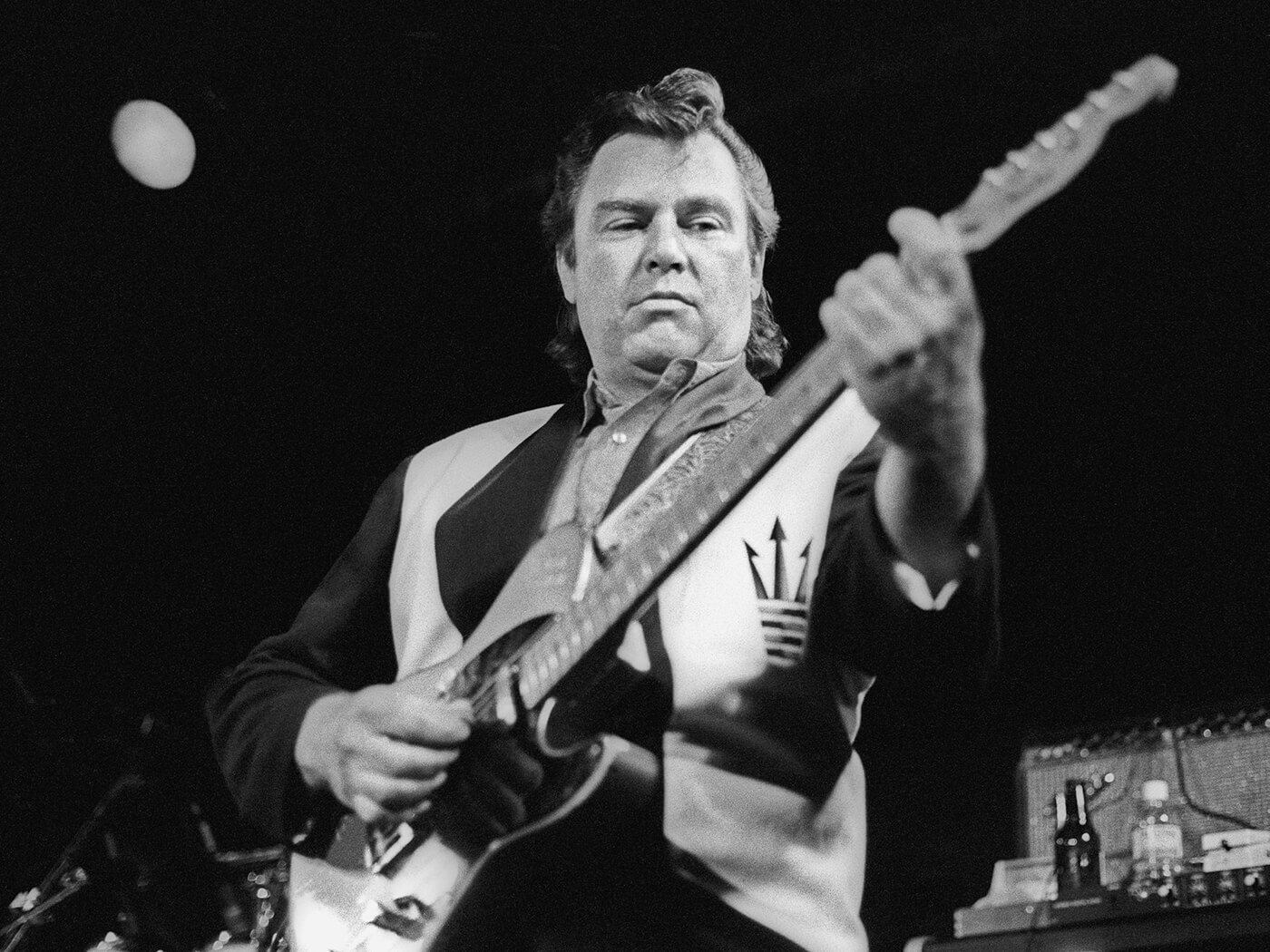Related Tags
Danny Gatton was a tinkerer, genre-hopper and Tele master
Blues, jazz, country, rockabilly – Danny Gatton mixed all these together, sometimes in the space of a single bar. This is the story of one of the greatest electric guitarists of all time, and a man who redefined what a Telecaster could do.

Danny Gatton playing a Fender Telecaster live at Slim’s in San Francisco on 2 July 1993. Image: Clayton Call / Redferns
When it comes to classic, state-of-the-art Telecaster playing, two artists rise above all others: Roy Buchanan, a country/roots maestro who made his music on a ’53 Fender Telecaster, and Danny Gatton.
Gatton played the same model guitar from the very same year, and he also crossed paths with Buchanan, some five years his senior and much more experienced, when he hung around Washington DC gigs in the late 60s to pick up tips.
Both men’s lack of vocal ability restricted their impact outside musicians’ circles, yet it meant that the guitar was their one and only musical voice. Both had an ambivalent attitude to fame; both, too, exited this life in tragic fashion. Yet Danny Gatton was his own man – one who pulled together so many styles of music in his playing that it proved to be his undoing. He once famously said “I can’t stand a whole night of one thing; it drives me crazy. I can’t even stand a set of one thing.”

He was dropped by Elektra Records two albums into a seven-disc deal precisely because his inability to limit himself stylistically (biographer Ralph Heibutzki called it ‘genre-hopping’) made his music tough to market in a category-obsessed business. Yet since his death in 1994 from a self-inflicted gunshot wound at the age of just 49, his reputation has continued to grow.
Gatton, whose love for cars ran parallel to his music, was a tinkerer who was fascinated by how things worked. Just as he’d often be found with his head under a car bonnet, he would hot-rod his guitars, starting with a 1956 Gibson ES-350 purchased for him by his father for $375 (Danny Senior was not amused). He chose the utilitarian Tele as his adult workhorse because it came with no preconceptions. A Les Paul? “Too many volume knobs, too many tone knobs, too much crap – plus you can’t bend the strings behind the nut,” Gatton opined. The Strat? “No – the middle pickup gets in the way.”
DC charge
Born in September 1945 in Washington DC, Gatton came from a musical family: his father had played in a dance band while his mother Norma was a country music fan. A guitar entered his life at the age of nine when the family moved to the suburb of Anacostia. Lessons lasted just six months: once he’d mastered the country standard Wildwood Flower, he decided he could figure out anything he wanted to. His first performance was in 1956 at the Cottage City Firehouse in Bladensburg, Maryland. He was all of 11 years old.
The music of Les Paul, to which his uncle introduced him at an early age, was perhaps his greatest influence, as much because of the technological innovations as his music. He slowed down Paul’s 45rpm records to 33 to get a better understanding of how the different parts were layered. Gatton even tried to emulate Les Paul by rigging up two tape decks to perform primitive overdubs. “I would play a track on the left machine,” he said, “run it into the right one with a Y cord, and play along with it. I created echo by doubling a part and playing a bit behind myself, which is hard to do when you’re about 12.”
Later heroes would include country-picking rock ’n’ rollers Carl Perkins and Scotty Moore, then jazzmen Charlie Christian, Howard Roberts, Wes Montgomery and Lenny Breau. Local hero and fellow Washingtonian Link Wray presented no challenge: “I’m not trying to brag, but by the time I heard Rumble I could play better than that.”
Danny started playing with local group the Thunderbirds, whose Gene Newport he credited for “teaching me how to play by ear”. He moved on to teen band the Lancers in 1957, playing his Gibson ES-350 and developing some amazing chops. Danny was left-handed yet played guitar right-handed, which may go some way to explaining his amazing speed and dexterity on the fretboard. In 1959, at the age of 14, Danny auditioned for an established and somewhat older band called the Offbeats. His skills overcame any doubts as to his youth, and he got the gig. He made his first recording with them, Beggarman/Trouble In Mind, in 1960.
In yet another curious echo of Roy Buchanan, Gatton was unwilling to follow fame by uprooting himself from Washington. The furthest he ventured was when the Offbeats played gigs in New York and other East Coast cities. Keyboardist Dick Heintze, who had been in Roy Buchanan’s pre-fame outfit the Snakestretchers, proved something of a musical father figure to the young Danny, but when the band split and Gatton travelled to the country music mecca of Nashville in 1967 with thoughts of making his name as a session musician, he returned, homesick, just six months later.

Friends with benefits
After a spell mixing sheet-metal work with country gigs as a hired hand with a band called Liz Meyer And Friends, Danny’s first solo album, American Music, appeared on in 1975. The standout was a version of what would become his theme tune, the jazz standard Harlem Nocturne featuring Dick Heintze on Hammond organ. He played live with a band called Danny and the Fat Boys.
At the heart of his music was the fact he’d never been seduced by the all-conquering rock guitar heroes of the 60s. “I was playing rockabilly with the Fat Boys when everyone else was into Jimi Hendrix,” he’d later explain. “I guess I’m a rebel at heart.”
He found work in the late ’70s as a sideman with Commander Cody and Roger Miller, seemingly as comfortable with hippie country convert Cody as the England Swings veteran. “I went out and played other people’s music and no-one could play mine,” said Gatton – which was as much of a boast as he ever managed to muster. Neither did he care about image. “Guitar players are supposed to look English and lean and hungry,” he once said. “I look more like a sheet metal worker.” Which, by day, he was.
One of the contacts Gatton made in Nashville during his short stay was pedal steel guitarist Buddy Emmons, and Danny became part of the Redneck Jazz Explosion, a band of hot musos playing country whose live tapes circulated widely. A studio album Redneck Jazz (1976) was followed two years later by the live Redneck Jazz Explosion. The trading of licks between steel and guitar was incendiary, with listeners treated to a musical mystery tour.
“One song may start as a bluegrass tune and turn into a bossa nova,” Gatton said. At this time Danny had temporarily forsaken his Tele for a rare 1961 Gibson Les Paul Custom. He added a bridge plate on which was mounted a switching unit he’d designed with his dad. He used this ‘Magic Dingus Box’ to control several effects units, including a Leslie speaker cabinet. It was, in retrospect, almost a primitive prototype MIDI multiple effects control, giving him access to a keyboard-type sound at the flick of a switch.
Making a living from music had always been an unattainable dream. “We like what you do but we don’t know how to sell it,” was the record companies’ refrain. In 1978, Gatton confided that if he had his time again, he would never play an instrument. “More often than not, it’s been miserable. I mean, I’m 33 and my wife’s 36 and… we have nothing. We can’t buy a house, because I can’t afford it.”
Impressive feat
Atlantic Records came sniffing, but Danny did not sign despite the financial rewards on offer. When interviewed by the Baltimore Sun, he revealed that he had just bought a small house on an acre of land – big enough for his three vintage cars, two dogs and a pet raccoon – and was about to become a father for the first time. “That’s all I ever wanted,” he told the reporter, “to have a house, a kid and be normal like anyone else.”
Yet there was an undercurrent of sadness beneath this cosy picture. He had lost three influential people in quick succession – his father, Dick Heintze, and Lowell George of Little Feat, who had talked about him joining his solo band – and was not in a state of mind to take the limelight. He even considered quitting music to concentrate on rebuilding cars.
Little Feat’s reputation, like Danny’s, had been boosted through bootleg live albums. One of these was The Humbler, which chronicled a show Danny played with new wave/rockabilly star Robert Gordon. After circulating as a bootleg for 15 years, this was one of several recordings released by Gatton’s mother Norma, the guardian of her son’s musical legacy. The name, incidentally, refers to his ability to reduce any challenger in a ‘cutting contest’ to humble contrition.

Danny got back with the Offbeats, now the American Music Company, whose new young singer Billy Windsor he would take with him when Elektra Records signed him in the early 90s. But he seemed content to play and record locally. A young singer called Eva Cassidy came to him for guitar lessons and, recognising her talent, he put her to work contributing vocals to tracks that would appear posthumously as the Untouchable album.
In the late 80s Danny Gatton was invited to make some teaching videos – and these, now of course available in DVD format, are invaluable. Danny’s first instructional video was Licks & Tricks For The Telecaster, on which he used the ’53 Tele and a silverface Fender Super Reverb. Telemaster was released three years later, while 1994’s Strictly Rhythm Guitar saw him demonstrating the art of backup with a Gibson J-200 and a black and white pearloid Telecaster. One trick he kept to himself was his habit of using a beer bottle to play slide: “Heineken for preference, but any brand will do…”
The buzz builds
But as much as he seemed intent on avoiding stardom, Gatton’s reputation was growing. A 1989 issue of Guitar Player called him “the world’s greatest unknown guitarist”, and while he was a world away from the top-hatted Slash, axeman du jour, he knew few rivals as a guitarist’s guitarist. The all-instrumental Unfinished Business (released in ’87 on NRG, the label founded by his mother Norma Rae Gatton) made him a hip name to drop in musicians’ circles, and was to prove the beginning of Danny’s long-awaited commercial breakthrough.
This finally came when the rockabilly-styled Elmira Street Boogie, a track from 1991’s 88 Elmira Street, won a Grammy nomination for Best Rock Instrumental. It seemed like the bells on the fruit machine had all lined up at last. But the album sold poorly, and only one more major label release, Cruisin’ Deuces, emerged in 1993 before a shake-up at Elektra left him out in the cold. He’d brought in guests Rodney Crowell and Delbert McClinton in an effort to appease the music machine and deviate from his instrumental-only policy, but money was the bottom line, and his albums just didn’t sell enough. Diversity did not add up to dollars.

Danny Gatton’s technique and musicianship were always going to appeal to fellow players, but it never got further than that. Even ringing endorsements like Entertainment Weekly’s “Danny Gatton lets his stunning electric-guitar chops loose on a barroom collection of R&B, rockabilly and blues…” didn’t shift sufficient units.
Even now, 30 years after his death, there is no shortage of legends ready to champion the late, great Gatton. Indeed, in 1998, just four years after his passing, a bevy of country/roots guitarists turned out in a two-day festival to honour his life. They included Albert Lee, Rodney Crowell, Steve Earle, John Jorgenson, Jerry Douglas, Vince Gill, Radney Foster, and Amos Garrett.
Many albums are available, thanks to the diligence of Norma Gatton, but perhaps the first step is to scour YouTube, where the sheer effortlessness of Danny’s style comes across better than on record. One excerpt from a 1989 gig shows him handing his Tele to a 12-year-old Joe Bonamassa. The youthful Bonamassa makes the most of an early turn in the spotlight. Yet as one of several hundred posters responding to the clip remarks, this was one teacher who would not be humbled by his pupil – or, indeed, anyone.
Learn more about the history of the Telecaster here.
